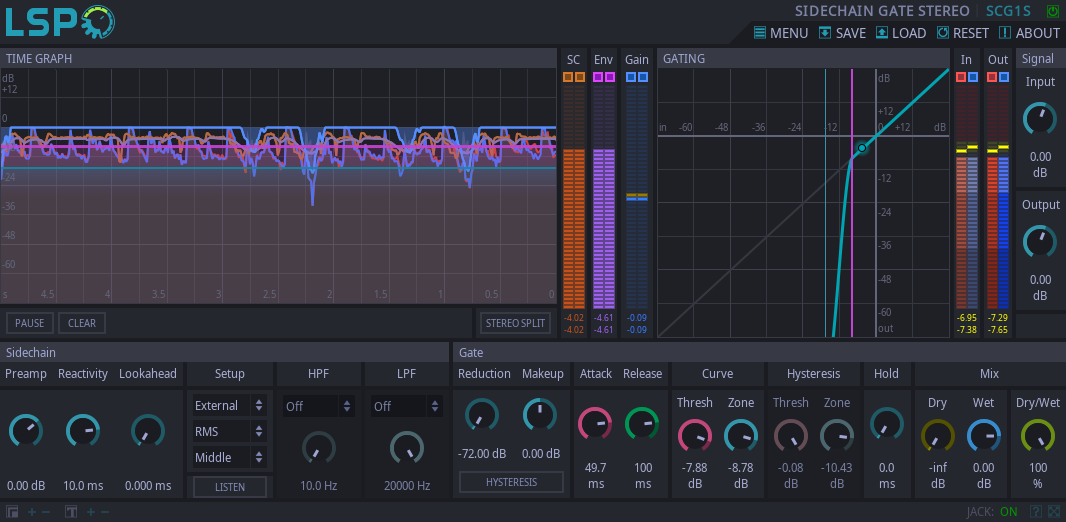Sidechain Gate Stereo

Detailed: LSP Sidechain Gate Stereo (SCG1S)
Formats: CLAP, JACK, LADSPA, LV2, VST2, VST3
Categories: Gate
Developer: Vladimir Sadovnikov
Description:
This plugin performs gating of stereo input signal. Flexible sidechain-control configuration and additional sidechain inputs are provided. Additional Hysteresis curve is available to provide accurate control of the fading of the signal. Also additional dry/wet control allows to mix processed and unprocessed signal together.
Additionally, Stereo split mode allows to apply processing to the left and right channels independently while keeping the same settings for the left and right channels.
Controls:
- Bypass - bypass switch, when turned on (led indicator is shining), the plugin bypasses signal.
- Pause - pauses any updates of the gate graph.
- Clear - clears all graphs.
- Stereo Split - enables independent processing of left and right channels.
- Gain L, R - enables drawing of gain amplification line and corresponding amplification meter.
- SC L, R - enables drawing of sidechain input graph and corresponding level meter.
- Env L, R - enables drawing of gate's envelope graph and corresponding level meter.
- In L, R - enables drawing of gate's input signal graph and corresponding level meter.
- Out L, R - enables drawing of gate's output signal graph and corresponding level meter.
- Link - the name of the shared memory link to pass sidechain signal.
- Pre-mix - shows pre-mix control overlay.
- Sidechain - shows the sidechain control overlay.
- Mix - shows the Dry/Wet control overlay.
'Gate' section:
- Reduction - the amount of gain applied to the input signal when the gate is closed (if negative) or open (if positive).
- Makeup - additional amplification gain after processing stage.
- Attack - attack time of the gate.
- Release - release time of the gate.
- Curve - Basic gate curve characteristics:
- Thresh - threshold, the level of input signal at which the gate becomes open.
- Zone - the size of the transition zone below the threshold.
- Hysteresis L, R - enables additional hysteresis curve:
- Thresh - threshold (relative to basic curve), the level of input signal at which the gate starts to close.
- Zone - the size of the transition zone below the hysteresis threshold.
- Hold - the time period the envelope holds it's maximum value before starting the release.
'Signal' section:
- Input - overall input gain.
- Output - overall output gain.
Pre-mix control overlay:
- In -> SC - the amount of signal from input channel added to the Sidechain.
- In -> Link - the amount of signal from input channel added to the shared memory link.
- SC -> In - the amount of signal from sidechain input channel added to the input channel.
- SC -> Link - the amount of signal from sidechain input channel added to the shared memory link.
- Link -> In - the amount of signal from shared memory link added to the input channel.
- Link -> SC - the amount of signal from shared memory link added to the sidechain channel.
Sidechain control overlay:
- Preamp - pre-amplification of the sidechain signal.
- Reactivity - reactivity of the sidechain signal.
- Lookahead - look-ahead time of the sidechain relative to the input signal.
- Setup - Sidechain configuration, available values:
- Internal - sidechain input is connected to gate's input.
- External - sidechain signal is taken from additional (external) sidechain inputs of plugin.
- Link - sidechain input is passed by shared memory link.
- Peak - peak mode.
- RMS - Root Mean Square (SMA) of the input signal.
- LPF - input signal processed by recursive 1-pole Low-Pass Filter (LPF).
- SMA - input signal processed by Simple Moving Average (SMA) filter.
- Middle - middle part of signal is used for sidechain processing.
- Side - side part of signal is used for sidechain processing.
- Left - only left channel is used for sidechain processing.
- Right - only right channel is used for sidechain processing.
- Min - the absolute minimum value is taken from stereo input.
- Max - the absolute maximum value is taken from stereo input.
- Left/Right - left and right channels are being processed using respectively the left and right sidechain channels in stereo split mode.
- Right/Left - left and right channels are being processed using respectively the right and left sidechain channels in stereo split mode.
- Mid/Side - left and right channels are being processed using respectively the middle and side parts of sidechain signal in stereo split mode.
- Side/Mid - left and right channels are being processed using respectively the side and middle parts of sidechain signal in stereo split mode.
- Listen - allows to listen the processed sidechain signal.
- LPF - allows to set up slope and cut-off frequency for the low-pass filter applied to sidechain signal.
- HPF - allows to set up slope and cut-off frequency for the high-pass filter applied to sidechain signal.
Dry/Wet mix control overlay:
- Mix Dry - the amount of dry (unprocessed) signal.
- Mix Wet - the amount of wet (processed) signal.
- Mix Dry/Wet - the knob that controls this balance between mixed dry and wet signal (see Mix Dry and Mix Wet) and the dry (unprocessed) signal.































